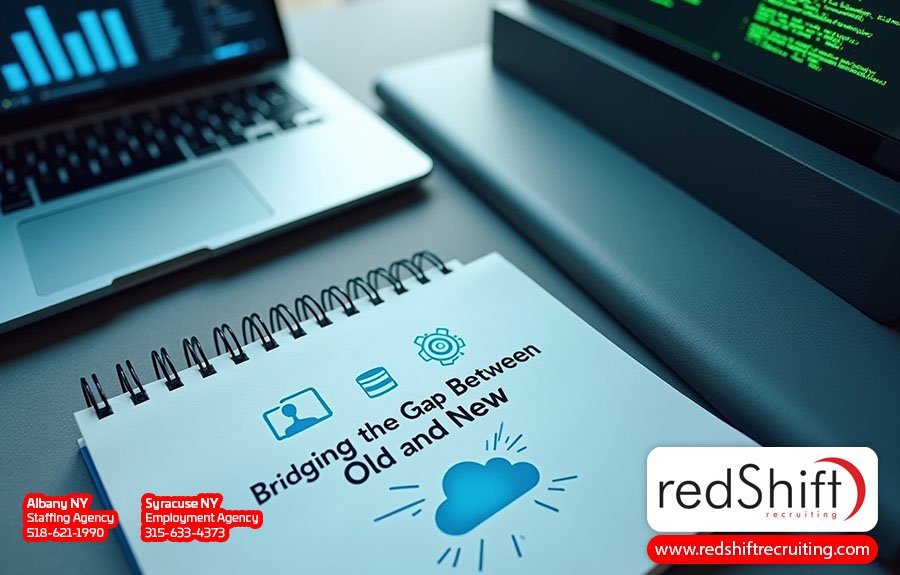IT Staffing for Legacy Banking Systems: Common Questions
Table of Contents
What Is a Legacy Banking System?
Why Do Banks Still Use Legacy Banking Systems?
What’s the Difference Between Legacy and Modern Banking Technology?
How Long Are Legacy Banking Roles Expected to Last?
What Industries or Companies Are Hiring for Legacy Banking Roles?
What IT Roles Are Commonly Needed for Legacy Banking Systems?
What Skills Should Legacy Banking IT Staff Have?
What Should I Look for in a Resume When Hiring for Legacy System Support?
Should You Look for Candidates With Both Legacy and Modern System Experience?
What’s the Future of Legacy Banking IT Roles?
Can You Hire Contract or Temporary Staff for Legacy Banking Projects?
What Are the Challenges of Hiring for Legacy Systems?
How Can a Staffing Partner Help With Legacy System Hiring Needs?
What’s the Best Way to Build a Hybrid Legacy-Modern IT Team?
Legacy banking systems still form the backbone of many financial institutions, quietly powering everything from loan processing to daily transactions. But maintaining and modernizing these systems presents unique challenges, especially when it comes to finding the right technical talent.
IT staffing for legacy banking systems requires a specialized approach, as employers must balance the need for deep institutional knowledge with the demands of a rapidly changing industry. In this article, we’ll answer the most common questions about legacy systems, the roles and skills required to support them, and the hiring strategies that can help you build the right team — whether you're maintaining your current infrastructure or preparing for long-term transformation.
🧠 Understanding Legacy Banking Systems
Legacy systems may not be flashy, but they still power the heart of many financial institutions. Before diving into the staffing strategies and roles needed to support these systems, it’s important to know what they are, why banks continue to rely on them, and how they differ from modern banking technology. This context is essential for identifying the right IT talent and understanding why hiring for legacy environments requires a very specific approach.
Legacy systems are long-standing technologies that continue to power many banks' most critical functions. They are often built on COBOL, batch processing, and mainframe infrastructure and typically support core banking operations such as loan processing, account management, and handling financial transactions.
They’ve been a mainstay in the banking sector for decades because they’re incredibly stable, efficient at high-volume processing, and deeply intertwined with existing software systems. However, they weren’t built to connect easily with today’s cloud platforms, APIs (application programming interfaces), or mobile applications. As a result, many institutions are now focused on modernizing banking legacy systems to improve performance, security, and integration with modern tech stacks.
Many financial institutions continue to rely on legacy banking systems because they offer reliability, stability, and decades of proven performance. Replacing these critical systems is often viewed as too risky — especially when they’re responsible for day-to-day operations like account management, loan servicing, and transaction processing.
The complexity of replacing outdated systems introduces significant operational risks, including potential downtime, data loss, or system failures that can impact customers and the institution’s reputation. Security concerns also come into play; rushing a migration can leave sensitive data exposed and threaten regulatory compliance if proper controls aren't in place. In many cases, legacy platforms have also been heavily customized over decades, making full replacement a complex and costly undertaking.
In addition, modernization efforts often come with high upfront costs, from infrastructure investments to retraining staff and rewriting software. While some institutions are hesitant to make the leap, digital transformation across the industry is making it increasingly difficult to ignore the limitations of aging systems.
While legacy platforms are known for their stability, they are often built on outdated technology that lacks the flexibility and speed of modern systems. One major limitation is the absence of application programming interfaces (APIs), which makes it difficult for legacy systems to communicate with external platforms or support real-time updates.
Modern banking technology is designed with agility in mind, and it typically leverages cloud computing, AI-driven analytics, and multi-factor authentication to enhance both security and scalability. These systems also support seamless integration with third-party tools and fintech solutions — capabilities that legacy platforms struggle to offer.
At the heart of this evolution is a shift in priorities. While legacy IT focuses on reliability and compliance, modern systems are built around innovation, speed, and meeting rising customer expectations for digital experiences. Understanding this gap is critical when evaluating the skill sets needed for today’s banking IT teams.
Many banks continue to depend on critical legacy systems for their core operations, and that reliance isn’t disappearing anytime soon. As long as these platforms remain in place, there will be strong demand for IT professionals who know how to maintain, troubleshoot, and upgrade legacy systems. Avoiding system failures is essential to minimizing risk and ensuring service continuity — especially in highly regulated environments.
With a shrinking pool of professionals who specialize in legacy technology, these roles are expected to remain in high demand for the foreseeable future, especially as banks pursue phased modernization efforts rather than full replacements. In many cases, organizations are creating hybrid environments that combine existing legacy infrastructure with modern technologies, making legacy knowledge an essential part of digital transformation strategies.
IT professionals with legacy system expertise are in demand across a wide range of organizations within the financial sector. These include traditional banks, credit unions, insurance providers, payment processors, and even government agencies. All of these entities rely on established core banking systems to support daily banking operations and require experienced staff to keep these environments secure, stable, and compliant. Some fintech firms, mortgage servicing companies, and third-party IT vendors also hire specialists to support or integrate with core banking systems.
These professionals often play a key role in ensuring uninterrupted banking operations, compliance reporting, and core transaction processing. As financial organizations pursue long-term modernization processes, they continue to seek professionals who can manage, support, and transition legacy environments without disrupting critical services.
🛠️ Roles and Skills You Need for Legacy Banking Systems
Keeping legacy systems running smoothly — and moving them toward modernization — requires the right mix of people. Whether you're maintaining critical infrastructure or planning for a long-term transition, having the right roles in place makes all the difference. This section looks at the key IT positions involved and the skills needed to support legacy systems in today’s fast-changing banking environment.
Maintaining legacy core systems requires a range of technical roles, each with its own area of responsibility. Common legacy maintenance positions include COBOL Developers, Mainframe System Administrators, Data Migration Specialists, QA Testers, Security Analysts, and System Integration Specialists. These professionals keep aging infrastructure stable and secure while ensuring systems remain compliant with financial regulations.
As digital transformation reshapes banking, the need for talent capable of both maintaining legacy platforms and supporting modernization is growing. Specialists who understand legacy code and architecture are vital during transitional phases, especially when integrating with newer systems or updating outdated processes. Some of these roles are also commonly filled on a contract basis, especially during major migrations or core system upgrades.
The rise of digital banking platforms has also expanded the demand for IT professionals who can bridge the gap between legacy and modern environments. Teams that blend legacy knowledge with experience in automation, data migration, and real-time systems are key to improving operational efficiency and delivering better customer experiences.
Working with legacy banking systems calls for a mix of technical expertise and strong interpersonal skills. On the technical side, professionals should have hands-on experience with legacy platforms and mainframe languages like COBOL, JCL, and Assembler. Familiarity with legacy workflow structures, regulatory reporting requirements, and the ability to protect sensitive financial data are all essential, especially in environments governed by strict banking regulations.
Understanding the underlying architecture of legacy infrastructure is also key to ensuring systems can be stabilized, integrated, or migrated without disrupting core operations. These professionals must be able to navigate complex environments, identify risk areas, and help prevent issues like data breaches during modernization efforts.
Just as important are soft skills like adaptability, communication, and problem-solving. Legacy environments often require cross-team collaboration, long-term planning, and the ability to work within constrained systems — making patience, critical thinking, and a proactive mindset vital to success. Once you understand the skills required, the next step is knowing what to look for when reviewing resumes.
When reviewing resumes for legacy support roles, prioritize candidates with hands-on experience maintaining or integrating core systems in the banking or financial services sector. Look for knowledge of data security practices, familiarity with regulatory requirements, and specific experience with legacy programming languages like COBOL, PL/1, or Assembler. Experience working on mainframe platforms such as IBM zSeries is also a strong indicator of relevant technical skills.
Ideal candidates will demonstrate a proven track record of working with legacy banking environments — including their constraints, operational risks, and compliance challenges. However, given the talent shortage, some employers may consider applicants with adjacent experience in system support or data architecture, particularly if they have exposure to innovative digital features and show a willingness to learn legacy platforms.
In these cases, a strong grasp of IT fundamentals, problem-solving ability, and an understanding of financial workflows can sometimes outweigh a lack of direct legacy experience, especially if the candidate will be working in a hybrid environment alongside more seasoned team members. Project work involving migrations, integrations, or hybrid infrastructure can also be a strong indicator of transferable experience.
Absolutely! Employers increasingly value hybrid candidates who understand both legacy core banking systems and modern technologies. These professionals are uniquely positioned to maintain critical infrastructure while contributing to innovation — a balance that’s especially important as digital expectations rise and systems become more interconnected.
With high maintenance costs and a growing shortage of legacy-experienced professionals, it’s becoming more difficult to find candidates who can support aging systems without slowing modernization plans. That’s why hiring individuals who can work across both environments is a strategic advantage, though demand for these candidates is high, and competition can be strong. These hybrid professionals are essential to modernizing legacy banking systems without disrupting operations, bridging the gap between traditional banking practices and future-facing digital strategies.
As digital banking services continue to grow, the roles supporting legacy systems are evolving. While some IT professionals will remain focused on maintaining existing systems, others are shifting into roles centered on system integration or legacy software modernization, especially as banks adopt hybrid environments that combine traditional infrastructure with modern cloud-based tools.
Security and compliance remain a top priority, particularly as institutions transition from batch to real-time processing. Professionals with expertise in regulatory requirements like the General Data Protection Regulation (GDPR), as well as experience with newer banking technologies such as digital loan processing, will be especially valuable as institutions adapt their operations to meet both regulatory demands and customer expectations.
Over time, roles tied strictly to legacy support may narrow, but the need for flexible, adaptable professionals will remain. Those who embrace continuous learning, stay current with emerging tools, and understand the nuances of risk management in both legacy and modern environments will be well-positioned to thrive in a changing industry.
📋 Hiring and Staffing Strategies for Legacy Banking
Hiring for legacy banking systems presents unique challenges, with the pool of experienced professionals shrinking and the skills required often highly specialized. Whether you're maintaining existing infrastructure or moving toward modernization, having a smart staffing strategy — including when and how to use contract talent — can make all the difference.
Yes — contract IT staffing offers flexibility and access to specialized expertise, making it an ideal solution during transitions, migrations, or when filling in for absent employees. Contract professionals often bring targeted legacy skills that aren’t readily available on internal teams, such as experience with outdated systems or niche programming languages.
Temporary staff can be brought in for specific phases of a project, helping to reduce the cost and commitment of a permanent hire. Contract-to-hire arrangements can also be a smart strategy, giving you time to assess technical fit and team dynamics before making a long-term commitment. Partnering with an IT staffing agency accelerates hiring and onboarding, so your team can move forward without delay.
Hiring IT professionals with experience in legacy systems is becoming more difficult for a wide range of reasons, with a shrinking talent pool, a wave of retirements, and a lack of formal training opportunities all contributing to a growing skills gap. Many younger professionals are focused on learning modern tools, leaving fewer candidates with the knowledge or interest to maintain older systems.
At the same time, experienced legacy specialists are aging out of the workforce, and competition from tech-forward companies can make it hard to attract the right talent. Some candidates may also hesitate to work with older technologies, worried that doing so could limit their long-term career growth.
Successfully staffing for banking legacy systems means thinking strategically. This may include investing in upskilling current employees, refining your job messaging to highlight career value, or working with a staffing partner that specializes in hard-to-fill roles. Some institutions are also exploring training pipelines or partnerships with educational programs to develop entry-level talent and build a future bench of legacy-capable professionals.
Finding candidates who can support outdated core systems and contribute to modernizing legacy systems is no easy task, especially with a shrinking talent pool and evolving technical demands. That’s where a specialized staffing partner can make a real difference.
Experienced staffing agencies have access to deep candidate networks and understand how to source niche IT professionals quickly and effectively. They can also vet candidates for both technical skills and industry-specific experience, helping ensure a better match for your role. Beyond sourcing, a staffing partner can manage the entire hiring process, from outreach and screening to interviews and final selection, making it easier to hire with confidence and keep your projects moving forward.
Building a high-performing hybrid IT team starts with combining deep expertise in existing legacy systems with the skills needed to support modern tools and workflows. This includes staff who understand mainframes, older programming languages, and traditional infrastructure, alongside professionals experienced in modern banking technology and emerging technologies like cloud computing, cybersecurity, and Agile development.
Encouraging collaboration between these groups is key, as knowledge-sharing helps bridge the gap between legacy and modern systems, reduces silos, and improves project outcomes. Fostering a culture that values both legacy expertise and forward-thinking innovation will help you create a well-rounded team capable of supporting day-to-day operations while driving long-term transformation efforts.
💬 Conclusion
Legacy banking systems may not make headlines, but they remain essential to the daily operations of many financial institutions. Supporting and modernizing these systems requires specialized IT talent — professionals who not only understand aging infrastructure but can also help bridge the gap to newer technologies.
As the talent pool continues to shrink and modernization efforts accelerate, employers need smart, strategic hiring practices to stay competitive. Whether you're building a hybrid IT team, filling high-impact roles, or navigating a system transition, the right staffing approach can make all the difference.
If you need help finding legacy-savvy IT talent, our team is ready to support your next hire!
Article Author:
Ashley Meyer
Digital Marketing Strategist
Albany, NY






